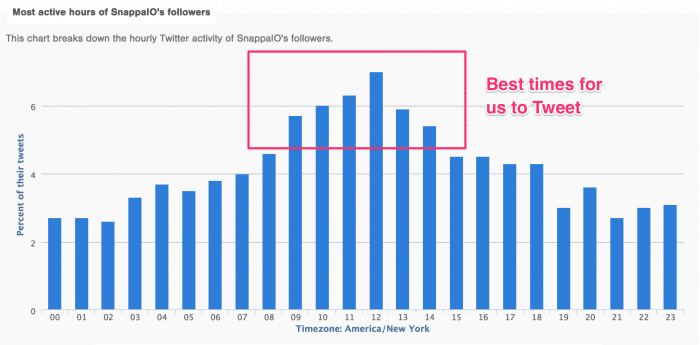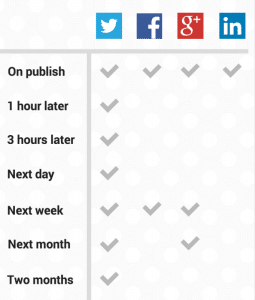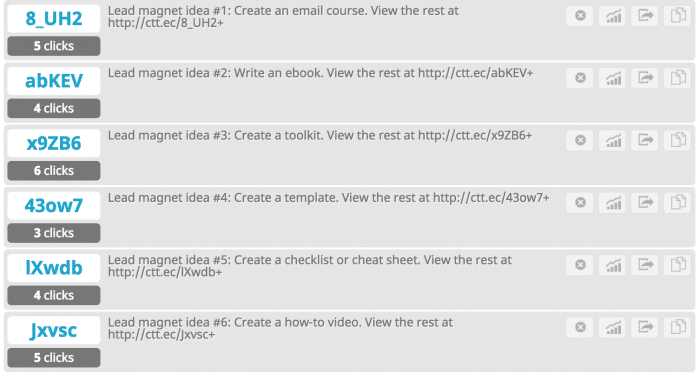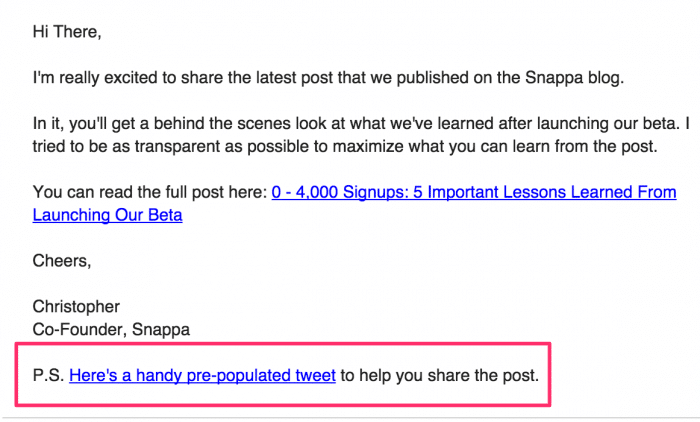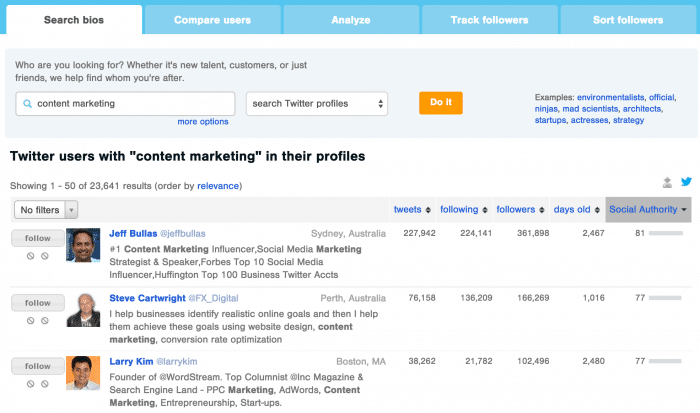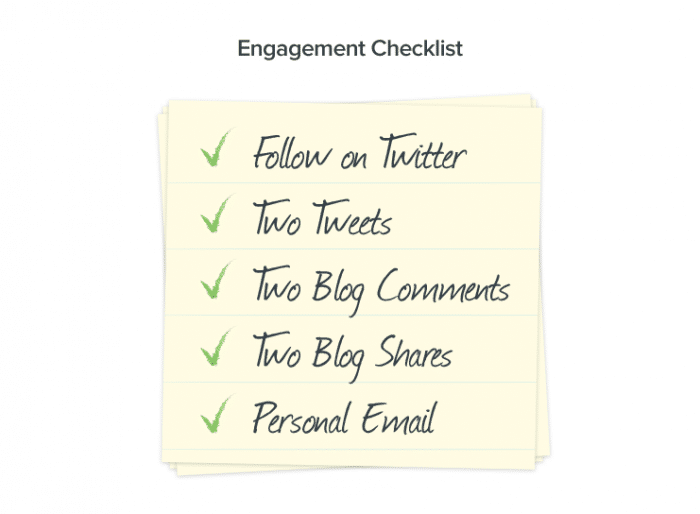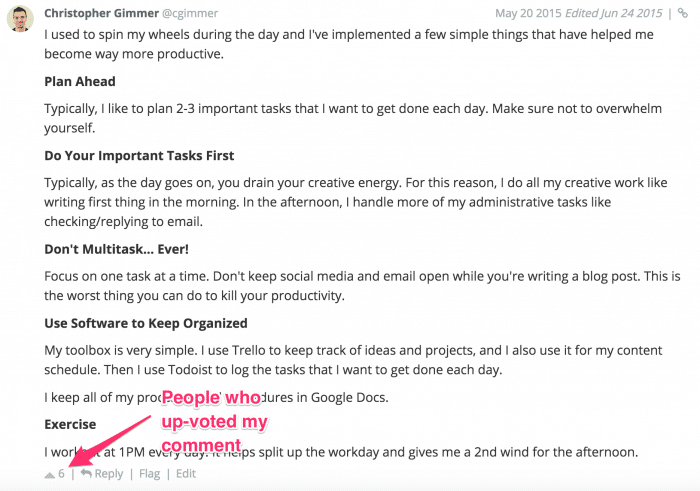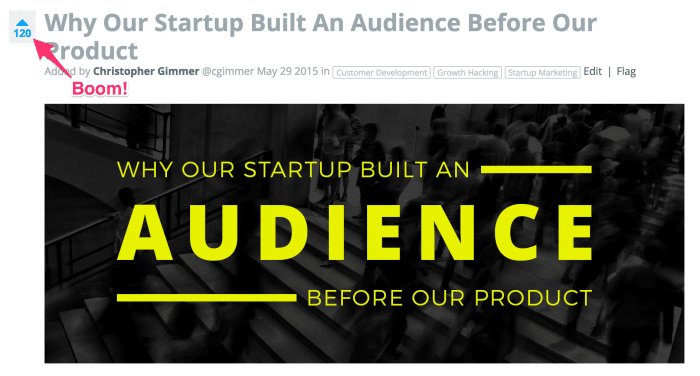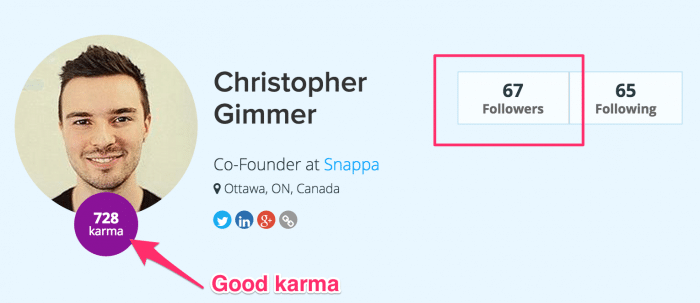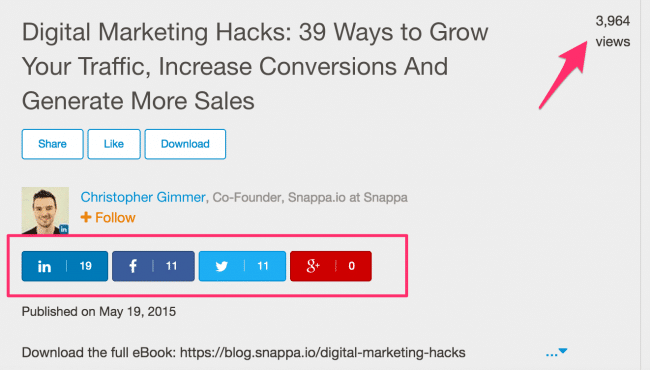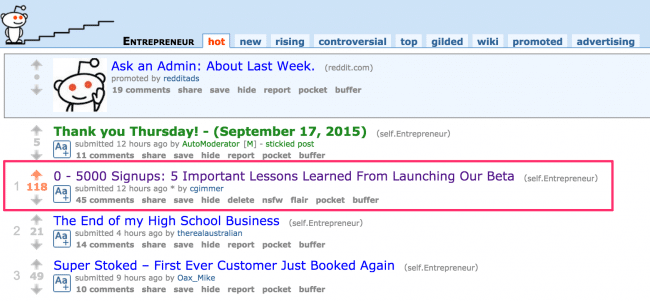If you’re cranking out dozens of blog posts per month and not seeing any results, you’re not alone. The issue is not necessarily the quality of your content rather how your manage to promote content via different content promotion channels

As more people start discovering the power of content marketing, the more difficult it becomes to stand out from the crowd.
Believe it or not, there are 54.2 million blog posts published on WordPress every single month.
For this reason, you need to be spending just as much time promoting your content as you are creating it.
In this post, I wanted to share 5 effective strategies we’ve used to promote our content at Snappa.
Social Amplification
Sharing your blog post on social media and calling it a day does not count as content promotion. Unfortunately, this is what most people do.
To get the most out of social networks, you really need to maximize the number of people that will see see your post. Then, you need to maximize the likelihood that they’ll share it.
Maximizing visibility
According to Moz, the average lifespan of a tweet is only 18 minutes. This means that if you tweet your updates only once, there’s likely just a small percentage of your audience that will see it. On a network like Twitter, you need to schedule your posts more than once to maximize the number of people seeing it.
To see when the best times to Tweet are, you can use a tool like FollowerWonk. Click the analyze tab, enter your Twitter handle, then select ‘analyze their followers’ from the dropdown menu. This will give you a breakdown of your followers and when they’re most active.
In our case, the best time to tweet is between 9AM and 2PM. We use this data to schedule multiple tweets throughout the day when our audience is most active. If you’re looking for a schedule to go off of, here’s what Buffer uses when they publish one of their posts.
When you’re scheduling a post more than once, make sure that you change up the snippet. For example, if you’re writing a post titled “5 Ways to Connect With Influencers” you might write a tweet that says: “Looking to connect with influencers? Here’s how to do it.” Another technique is to pull out quotes or stats from the article and use that as a tweet.
Whenever we publish a new blog post, we schedule multiple tweets using Buffer. For each one, we’ll write a different snippet and create separate image using Snappa. This ensures we get maximum visibility for each post that we publish.
Maximizing shares
One of my favorite ways to maximize social shares is with a tool called Click to Tweet. This enables you to create pre-populated tweets that others can share simply by clicking the link.
Click to tweets tend to perform well when placed after quotes or statistics. They also work well for list posts.
When we wrote a post about 9 irresistible lead magnet ideas, we added a click to tweet after each list item.
On average, this lead to 5 shares for each item on our list. That’s 45 shares in total! For a relatively new blog, this was very impressive.
Emailing Our List
If you want to have any success with content marketing, growing an email list is one of the most value added activities you can focus on.
While algorithms continue to change and social media feeds become more and more crowded, email allows you to communicate directly with your audience.
According to MailChimp, average open rates are anywhere from 17% – 30% depending on the industry. If you’re sending out valuable content on a consistent basis, I’m sure your open rates will be even higher. We typically see 30% – 40%. Compare that to the engagement you typically get on social media and you can see why an email list is so important.
First things first: you need to build your list. You’ll want to install a list building plugin like SumoMe or ThriveLeads to begin capturing email addresses. If you want to boost your conversion rate, put together a lead magnet that your audience will find useful.
Once you have a list, notify your subscribers each time you publish a new post. We take it one step further by including a pre-populated tweet that encourages them to share the post (also part of social amplification).
Here’s an example of an email we’ll send to our blog subscribers.
Influencer Outreach
Getting influencers to share your content is the key to unlocking serious growth for your blog. You can write the most epic post in the world but if no one shares it, it’s essentially useless.
To find influencers in your industry, you can search bios with Followerwonk. It will present you with a list of profiles that contain your search terms and you can filter even further by location and number of followers.
If you want to take your prospecting to the next level, you can use a premium tool like Ninja Outreach.
Once you’ve identified your influencers, you’ll want to engage with them and start building a relationship. By doing this, they’ll be way more receptive to helping you out when you need it.
Alex Turnbull from Groove uses the following checklist for each influencer he tries to build a relationship with.
If you’re targeting someone that’s really high profile, tweeting and commenting on blogs might not be enough. If that’s the case, you might want to try some of these unconventional ways to get on their radar.
Now that you’ve engaged and built a relationship, you can reach out and let them know about your content.
Now before you do, here’s a tactic that works extremely well: mention the influencer in your post.
By using an influencer as a reference or a resource, it makes them look good and they’ll be much more likely to share the post.
Here’s a typical email that we send to every influencer that we mention in our blog posts.
“Hey [Influencer],
I just wanted to let you know that I really enjoyed your post on [topic x]. I especially liked the [y] tactic that you discussed.
Since I found it so useful, I decided to reference it in my latest post about [z]. If you want to check it out, here is the link.
[Link to post].
All the best,
Christopher”
More often than not, they’ll reply back to say thanks and that they’re going to share the post.
Leveraging Communities
No matter what industry you’re in, there’s likely an online community with like-minded people. Leveraging these communities can be a great way to get your content out there.
They key to succeeding on community sites is always the same: provide value. The more value you provide, the more receptive they’ll be to your content.
This was our mission when we started targeting Inbound.org as a relevant community to participate in.
One of the ways I provided value was leaving thoughtful comments in threads. When someone asked what other members were doing to save time and be productive, I wrote out 5 highly actionable tips.
Another thing I did was share other people’s posts. Not only does it help out the community, but it even boosts my own karma if people upvote it.
Finally, I even wrote a guest post specifically for the Inbound community which was very well received.
Because I’ve provided value and engaged with other community members, I’ve now wracked up some decent karma and other members are following me.
Now when I do share a post, it gets much more engagement compared to other members who aren’t providing value.
As one final tip, it’s always great to get an influencer to share your post on your behalf. It’s not self-promotional and influencers carry much more weight on community websites.
When Brian Dean from Backlinko shared one of my posts on GrowthHackers, it immediately shot up to the top and gained a ‘must read’ status. Had I shared this post myself, it wouldn’t have done nearly as well.
Content Repurposing & Syndication
It takes a lot of time and energy to create brand new content. However, the same piece of content can be repurposed in just a fraction of the time.
Not only does repurposing your content save you time, it also opens you up to a whole new audience.
To jump start our email list for the Snappa blog, we put together an eBook containing 39+ marketing hacks to grow your business. The eBook took quite a bit of time to create. So instead of using it for one purpose, I turned it into a slide deck and uploaded it to SlideShare.
The presentation ended up generating nearly 4,000 views and a few dozen shares on social media. The presentation took 30 mins to put together compared to the 20+ hours it took to write the eBook.
Apart from repurposing your content, you can also syndicate it across other platforms like Medium and LinkedIn Pulse. This gives your content exposure to people outside of your own network.
Recently, I took an existing piece of content and modified it for the Entrepreneur Subreddit. The post did so well that I spent the majority of the day at the number 1 spot.
This lead to several hundred people visiting our website and a good chunk of them signed up to try our product.
So if you find that you’re not getting enough traction to your own blog posts, try looking at other avenues to repurpose and syndicate your content.
Conclusion
If you want to be successful with content marketing, content promotion is key.
This post should give you some highly actionable ways to promote your content and broaden the reach so more people can see it.

